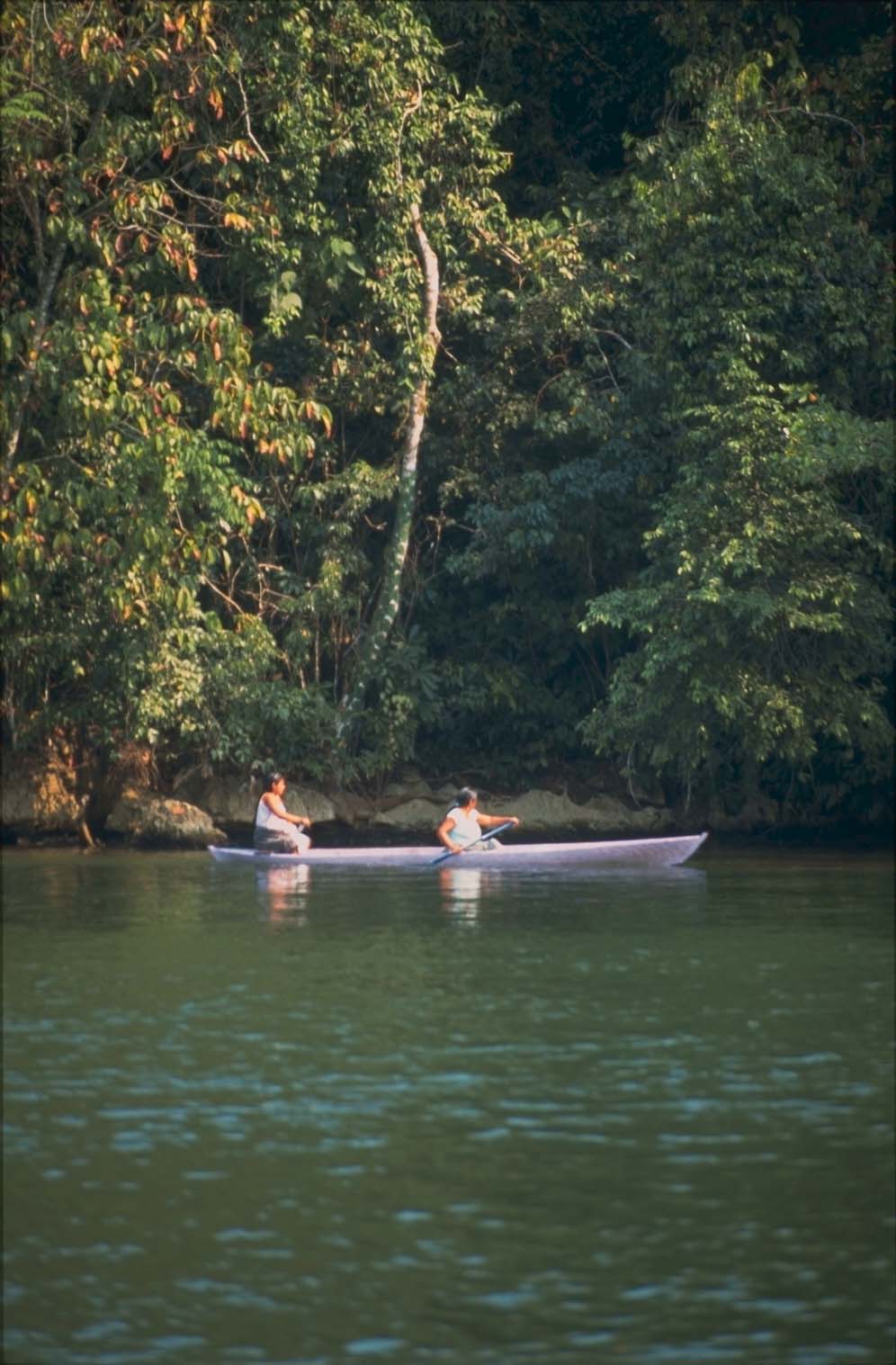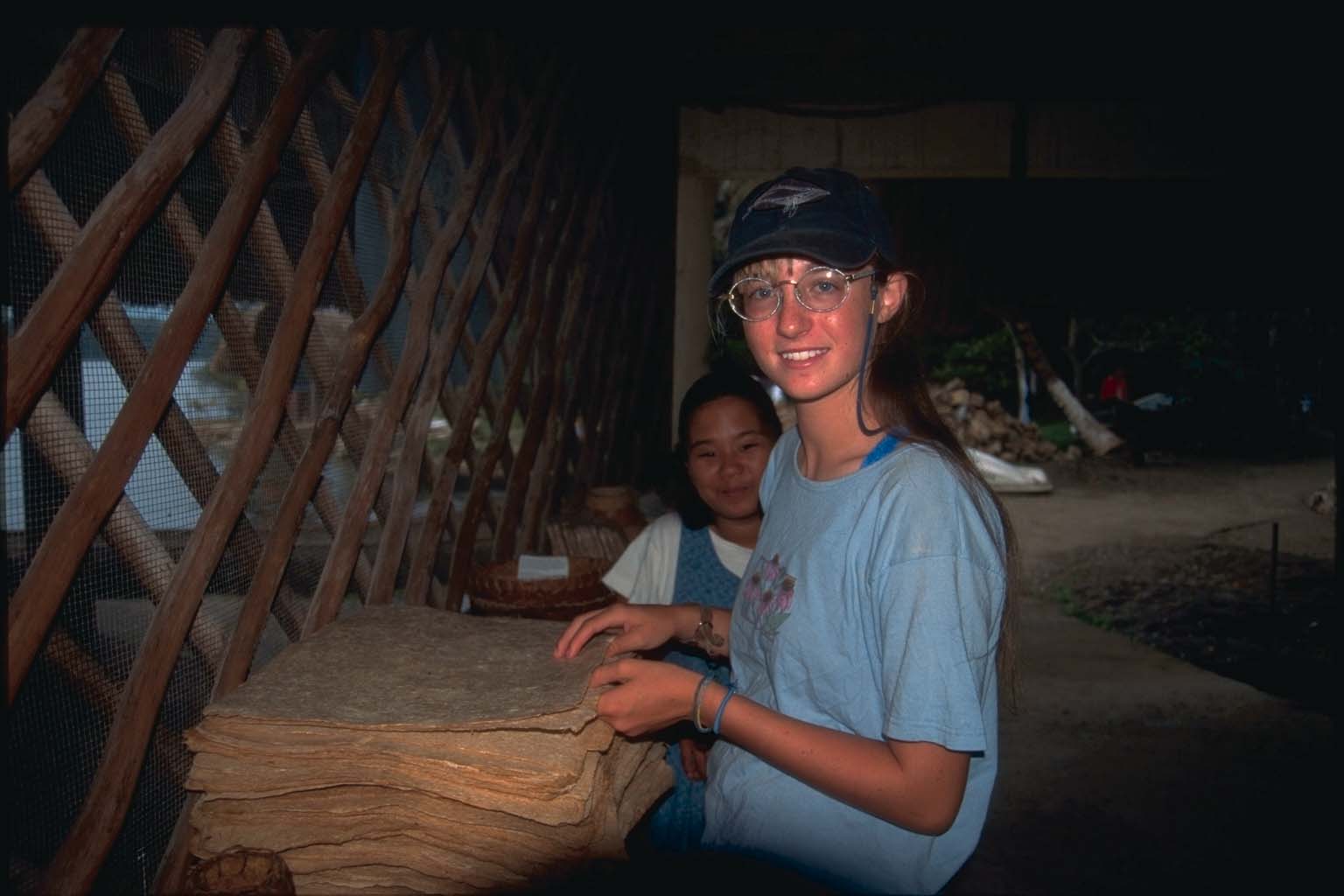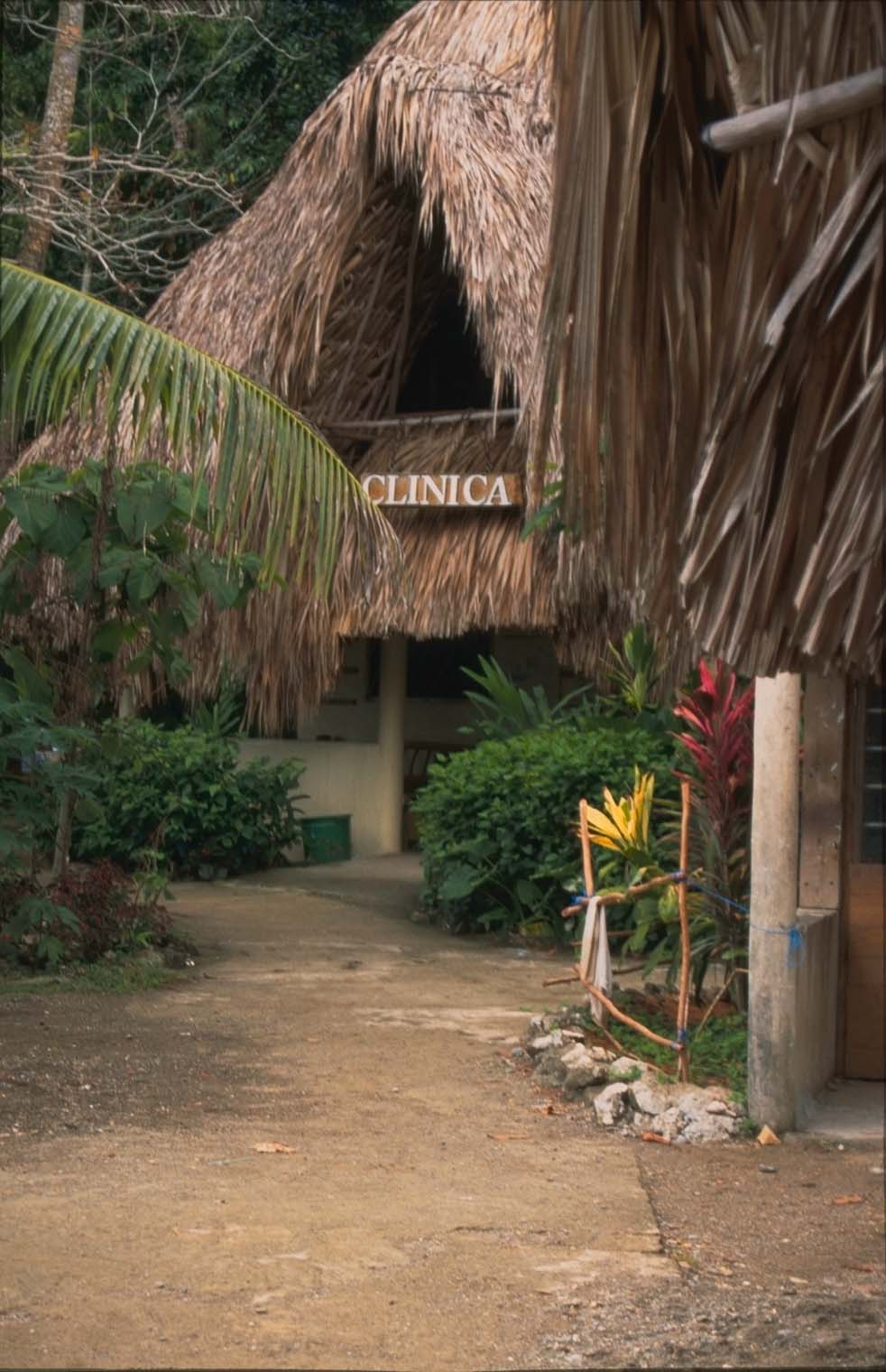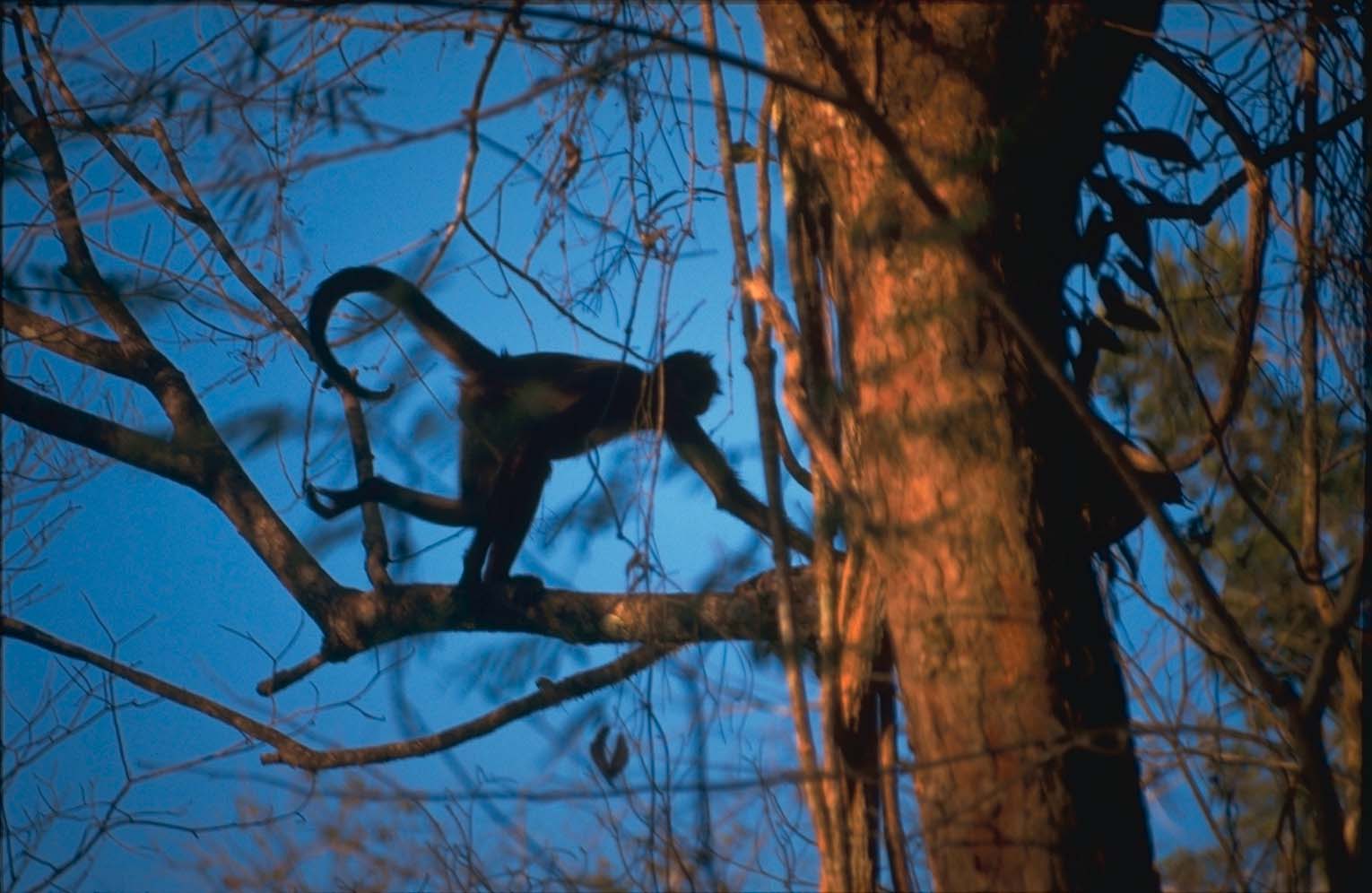
in the rainforest.
Cruising the Northwest Caribbean
Guatemala’s Rio Dulce
By Barbara Theisen
The sea was flat, the sun beat down and there wasn’t a hint of a breeze to be found. Out of Bounds motored the 16 miles from Punta Gorda, Belize towards the town of Livingston on Guatemala’s Caribbean coast.
I checked and rechecked the tide schedule and read and re-read our guidebook’s instructions on crossing the bar and entering the Rio Dulce. We only draw five feet and the bar carries 5.5 feet at Mean Low Water. But still I worried. It was my job, I had decided, since no one else on Out of Bounds ever seemed to do it.
Our directions were simple, pass the sea buoy (if it’s still there) keeping it about 100 feet to your port side on a course of 225 degrees until the red roofed house on the shoreline is split in half, then come to a course of 205 degrees until red roof disappears and the Texaco dock is bearing 300 degrees.
 |
| Mayan Women paddling a cayuco (traditional dugout canoe) in the rainforest. |
My husband Tom was at the helm, daughter Kate was watching the depth sounder, daughter Kenna was making sandwiches and I, well let’s
just say that I was wondering if that was really the correct red roofed house that we were heading for.
Naturally, we crossed the bar with never less than a foot of water under the keel. No problems! We had entered the fabled Rio Dulce.
Winding through a tropical rainforest rimmed with mountains that are often hidden in mist, the Rio Dulce, which means sweet river, flows 20 miles from the Caribbean Sea inland to Lago Izabal. But before we could head up this beautiful river, we would need to go through the formalities and paperwork of checking into the country.
By early afternoon we anchored in about 8 feet of water. We launched the dinghy and headed into the town of Livingston where
we would need to visit the Port Captain’s Office, the Immigration Office and finally, the Custom’s Office. Unfortunately we didn’t make much progress as we needed to pay our fees in quetzals, the Guatemalan currency, and the bank had closed at noon. We wouldn’t be able to convert any money into quetzals until tomorrow morning.
We walked around the small town of Livingston, which sits atop a hill overlooking the Caribbean Sea. This town of just over 5,000 people is only accessible by boat. There are no roads connecting this part of Guatemala with the rest of the country. Livingston is populated by Garifunas. They are descendants of African slaves who were brought to the Honduran island of Roatan. They speak Spanish, a traditional Garifuna language, and also some of the musical English of Belize. We found Livingston to be a rather laid back community. The next day we finished checking into Guatemala and by early afternoon, we were ready to start up the river.
One of the highlights of our entire cruise through the Northwest Caribbean was sailing up the Rio Dulce. Although the trip from Livingston, at the mouth of the river, to the twin towns of Fronteras and El Relleno, near the entrance to Lake Izabal can be done in a day, we took our time heading up the river, savoring the sights and sounds of this incredible area.
The name Rio Dulce refers not only to this freshwater river, but also to this entire region (including the 7,200 hectare protected Parque Nacional Rio Dulce) and often times to the twin towns of El Relleno and Fronteras, which are separated by the river itself and located 20 miles upriver from the Caribbean town of Livingston. A highway passes through these two towns (which are now connected by a high rise bridge across the river) but there are no other roads in the entire Rio Dulce region. The river is the mode of transportation here. It is the lifeblood of this area.
As we traveled up the first six miles of the river, it twisted and turned its way through an incredible canyon, where limestone cliffs, covered in tropical vegetation, rose 300 feet above the river. Kate and I hopped in the dinghy so that we could videotape and take photos of Out of Bounds sailing through this spectacular scenery.
As we continued, we saw Mayan Indians paddling their dugout canoes – called cayucos – up and down the river. In this very isolated region of eastern Guatemala, the Mayan Indians still live a simple life. They live in thatched-roof huts called palapas, cook on open fires and have no electricity or running water. They grow a few crops such as corn and beans, gather bananas from the rainforest and they fish the river.
In late afternoon, we stopped and put down the anchor near the north shore of the river. We were anchored near Ak’ Tenamit, a community outreach program dedicated to empowering the approximately 9,000 Q'eqchí (kek' chee) Mayan people living in more than 50 villages in and around the Rio Dulce through various programs in health, education and in teaching these families how to generate income. This project was begun in 1992 and is helping to improve the lives of the Mayan people. For more information on Project Ak’ Tenamit log onto their website at:
http://www.guatfund.org/.
Kate and Kenna had been collecting donations and had raised money over the past year so that they could buy school supplies for the children at Ak’Tenamit. They had come up with some rather ingenious ways to raise money. One week, when we were hauled out at a boatyard, Kate and a friend from another boat, bought supplies to make sandwiches. They went around the boatyard getting lunch orders and making and delivery sandwiches. They donated all of their profits to their Ak’Tenamit fund. We then used the money to buy notebooks, pencils, crayons, scissors, etc. and had carefully packed them away. Tomorrow we would deliver them in person.
 |
| Kate and Kenna Theisen look at handmade paper at Ak’Tenamit, a community outreach for the local Ketchi Mayan Indians. |
That evening we took the dinghy across the river to a thatched roof, open-air restaurant where we ate fish that was freshly caught from the river. We were the only patrons at the restaurant that night and from our table on the second floor we overlooked the peaceful river. Out of Bounds sat quietly at anchor, cayucos silently paddled by, and heavy clouds slowly enveloped the peaks of the surrounding mountains.
The next morning we awoke to a light mist and refreshingly cooler temperatures. The mountains, shrouded in mist, were beautiful. We sat in the cockpit eating breakfast while overhead a flock of parrots flew by and school kids paddled their cayucos to Ak’ Tenamit. There were usually 3 or 4 kids to a cayucos, one who was always bailing. The cayucos had almost no freeboard. The kids, who were paddling these handmade canoes, dug out from mahogany trees, were all wearing American style backpacks!
Soon we were approached by an ancient looking man in his cayuco who asked if we would like to buy some bananas. His machete indicated that they had been freshly cut. “How much?” I asked in Spanish. He replied that they were 10 quetzals, the equivalent of about 70 cents. We bought the bananas. Now, what to do with over 100 bananas? First, we tied the stalk to a line and hung them overboard. Stalks of bananas usually come complete with a rainforest spider or two. After we were pretty sure that we wouldn’t be bringing any visitors aboard, we hung the bananas to dry and then proceeded to split up the stalk. Some of the bananas were hung in the sun to ripen quickly, others were put down below and still others were put in a dark closet. We had bananas ripening at various times for the next couple of weeks.
Before the banana vendor paddled away, he asked if his wife could bring us some tortillas tomorrow. “Si,” we all agreed in Spanish. We make our own homemade tortillas aboard Out of Bounds, but as good as they are, it would be nice to have some authentic tortillas delivered to the boat.
We gathered up our school supplies and dinghied over to Ak’Tenamit. We met with some of the school children who were very grateful for the supplies that we had brought. These children are the first generation to have received any kind of education. We met a couple of
girls who were the first girls ever to be studying beyond the 6th grade. Many of the kids come from villages miles and miles away. Those from the farthest villages can live right at Ak’ Tenamit.
 |
| The medical clinic at Ak’ Tenamit, a community outreach program for the local Kekchi Mayan Indians of the Rio Dulce. |
While at AK’ Tenamit, we also visited the handcraft shop where we learned about a traditional Mayan art which has recently been reintroduced to area women, papermaking. The women of the Rio Dulce area are nearly all illiterate. They speak no Spanish and seldom leave their villages. But by learning how to make paper from corn husks and banana stalks, these women are now making gift items such as books, bowls, cards, bookmarks and artist’s paper. These items are now sold not only at the shop here at Ak’ Tenamit, but also in gift shops throughout Guatemala. This is one of several ways that the project has helped teach the indigenous people ways to generate income without depleting the rainforest’s or river’s resources.
The next morning, from the cockpit of Out of Bounds, we saw a cayuco approach. In the front a distinguished looking women paddled. In the back, paddled a very pretty younger lady with a baby sitting between her legs. The older woman began to speak, but in a Mayan dialect. The younger lady finally translated into Spanish the fact that they had no tortillas to sell us but that they did have freshly made potato empanadas. Our banana man hadn’t forgotten us.
We bought the empanadas, which are a corn masa filled with potatoes and spices, then made into a “turnover” which are then fried. They are served topped with a coleslaw type salsa. The older lady had a basket of the hot empanadas, which were wrapped up in a cloth. Although she spoke no Spanish and we spoke no Mayan, all of the communication had to go through her, with the younger woman translating when necessary. The older woman was also in charge of the money. These empanadas were some of the best food we have ever eaten! And delivery by cayuco was free.
As hard as it was to leave this tranquil area of the Rio Dulce, it was time to head further up the river. We hauled up the anchor and with final waves of good-bye to the students lining the Ak’ Tenamit dock, we set sail towards El Golfete. This is where the Rio Duce gives way to a 10-mile long bay. The bay was easy to transit, with average depths of 10 – 15 feet. At the western end of El Golfete, the shore was beginning to be lined with luxurious homes each with a large boathouse to store a luxurious powerboat. These are vacation homes of wealthy Guatemalans who have discovered this paradise. The cayucos must now share the rio not just with cruisers but also with jet skis.
After exiting El Golfete, the river enters what is often the ultimate destination of cruisers and is simply called the Rio. Here the river widens a bit and several marinas including Mango Marina and Mario’s Marina, as well as several lovely anchorages, are located. We had reserved a slip at Mario’s.
There are no roads going to the marinas here. Instead we took the dinghy – about a 20-minute ride to the towns of Fronteras and El Relleno. These two towns could best be described as backwater boomtowns. Here we discovered an eclectic community of locals, foreign yachties, expatriates, backpackers and volunteers (who give their time at the nearby Casa Guatemala Orphanage). You’ll hear a wonderful mixture of Spanish, English and several Mayan dialects spoken.
Although eco-tourism is a growing industry here, you won’t find any high-rise hotels - or high-rise anything. There are no ATM machines (the closest is in Morales, about an hour drive away). There are no nightclubs – just friendly open-air cafes with good music that serve the popular Guatemalan beer, Gallo.
We were looking forward to an inland trip to the magnificent Mayan ruins of Tikal, located in northern Guatemala. But both of our guidebooks warned that there was no easy way to get to Tikal. One recounts a nine-hour ordeal riding a bus over a nearly impassable road and in conclusion recommends flying to Tikal. The other book suggests going from Belize City, which is only 142 miles from Tikal, but leaves the problem of where to safely leave your boat.
Fortunately, things have changed! There is now a newly paved road from the town of Fronteras at the Rio Dulce to Tikal. It’s 208 km from the Rio to the town of Flores, which is about 70 km from the park. The road is in good condition and by private car, the trip takes about 3 – 4 hours. We could safely leave our boat at Mario’s Marina.
Driving to Tikal was an easy expedition. The highway is not as heavily used nor is it as mountainous as the highway to Guatemala City (known as Guate). We found it a much more relaxing trip then the hair-raising drive to Guate where busses come careening around mountain curves and vehicles pass where it clearly is not an intelligent thing to do. However like all roads in Guatemala you must keep a good lookout for livestock on the road. A Brahma bull is large, doesn’t move fast, and gives drivers a look that leaves no doubt that he owns the road.
We stopped for lunch halfway between the Rio and Tikal at the Finca Ixobel near the town of Poptun. This is a laid-back “backpacker” type hostel that serves a limited menu of great sandwiches – vegetarian the specialty. We had a wonderful lunch here that was served outdoors at picnic tables. Kate and Kenna loved the friendly toucans that landed at our table hoping for a nibble of their sandwich.
 |
| A spider monkey climbs a tree in the rainforest near Tikal in Guatemala |
The Mayan ruins at Tikal are truly one of the most incredible places we have ever been to. The park opens early (our guidebook said 5AM but the day we visited it opened at 6AM). The park is nearly deserted between opening and about 9AM, so we had the place virtually to ourselves. The tropical rainforest temperatures are more tolerable at this time of day and we found that this is the best time for viewing the abundant wildlife, which will be napping during the heat of the day. From the visitor’s center to the Great Plaza it’s a wonderful hike of a little more than 1 km. Along this path we saw dozens of spider monkeys, toucans, scarlet macaws, parrots and more. We also heard the dog-like howl of howler monkeys. We were visited by friendly coatimundis, a member of the raccoon family.
Tikal National Park is a 575-sq-km preserve and the ruins themselves are spread over quite a large area. You would probably need three days to explore the entire park but we saw a lot in our one long day.
We climbed the steep temples during the morning and late afternoon and headed back to the Visitor’s Center for lunch and a nice shady spot to rest during the heat of midday. We found that by 3 or 4 in the afternoon, we once again had the park to ourselves. Most tourists arrive by tour bus between 9 and 11 in the morning and leave between 3 and 4. The park stays open until 6PM.
Back at the Rio Dulce, we did some more sightseeing. One day we went to a hot waterfall. Hard to believe that in 95 to 100 degree heat we would want to go to a HOT waterfall, but away we went to Agua Caliente. After walking through the jungle we came to a river where a 25-foot waterfall of hot spring water spills into a cool mountain stream.
Another day we went to the nearby Mayan ruins of Quirigua, with the largest known Mayan stela (intricately carved stones). Although these ruins are small, the stela were very impressive. While there, we actually watched the maintenance man “mowing” the grounds with a machete.
To get to the ruins at Quirigua, we had to drive through a Dole banana plantation. Although this was very interesting in it’s own way, it brought up some great discussions with the girls. Bananas are a native rainforest “crop.” Their fruit helps to feed the world. The large corporations – Del Monte, Dole, and Chiquita - appear to provide good housing complexes, schools and medical care for their workers, as well as good pay. Yet, large tracts of rainforest must be cleared for the plantations. How do we best use the resources of the rainforest, while providing a good life for it’s native people, without destroying this important ecosystem? Our homeschooling studies definitely included studying both the rainforest in science and the Mayans in social studies.
We found Mario’s Marina to be a real delight. The grounds of the marina bloomed with orchids and hummingbirds were everywhere. We could spend hot afternoons in their cool pool or enjoy a breeze in their open-air bar, The Cayuco Club. Once a week cruisers got together for a potluck barbeque by the pool. Another night each week cruisers from the area were invited to a potluck at The Cayuco Club. Mario’s provided the main dish and the cruisers brought the side dishes. Other nights we might enjoy the all you can eat pasta or taco bar. Cooking on the boat was just too hot!
Many cruisers rank Guatemala’s Rio Dulce as the ultimate Caribbean cruising destination. With its incredible scenery, fantastic Mayan history, laid-back way of life, and low costs, the Rio Dulce is a very attractive cruising ground. To top it all off, the Rio Dulce is considered to be out of the hurricane zone, which means that cruisers can take their boats to the rio during the hurricane season and not only be insured, but know that they are in a safe area.
Cruising the Rio Dulce is like entering another place and another time. The pace of life is slow here and there’s a feeling of mystery that, along with the tropical heat and humidity, envelops you. It’s a feeling that you’ll never forget.
Barbara Theisen has spent the past ten years living aboard Out of Bounds with her husband Tom and daughters, Kate and Kenna. For more information on living the cruising life visit the Theisen’s Website at www.TheCruisingLife.com.